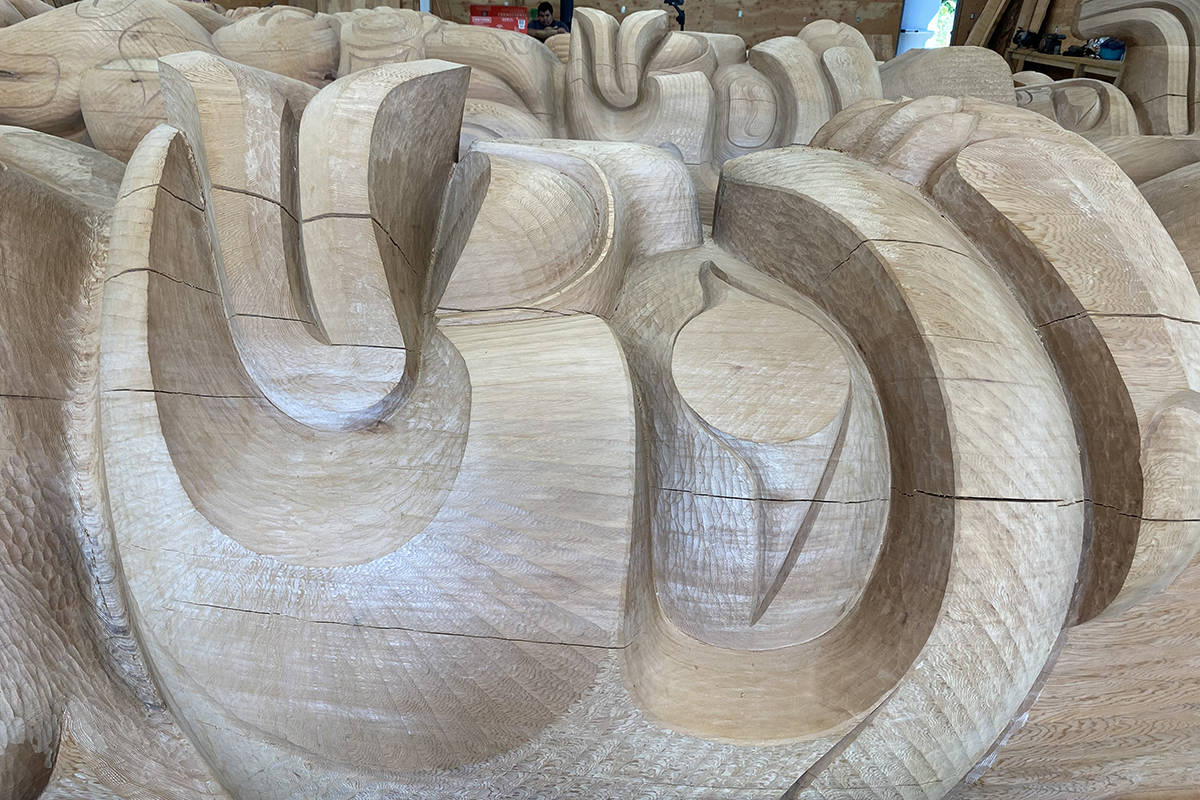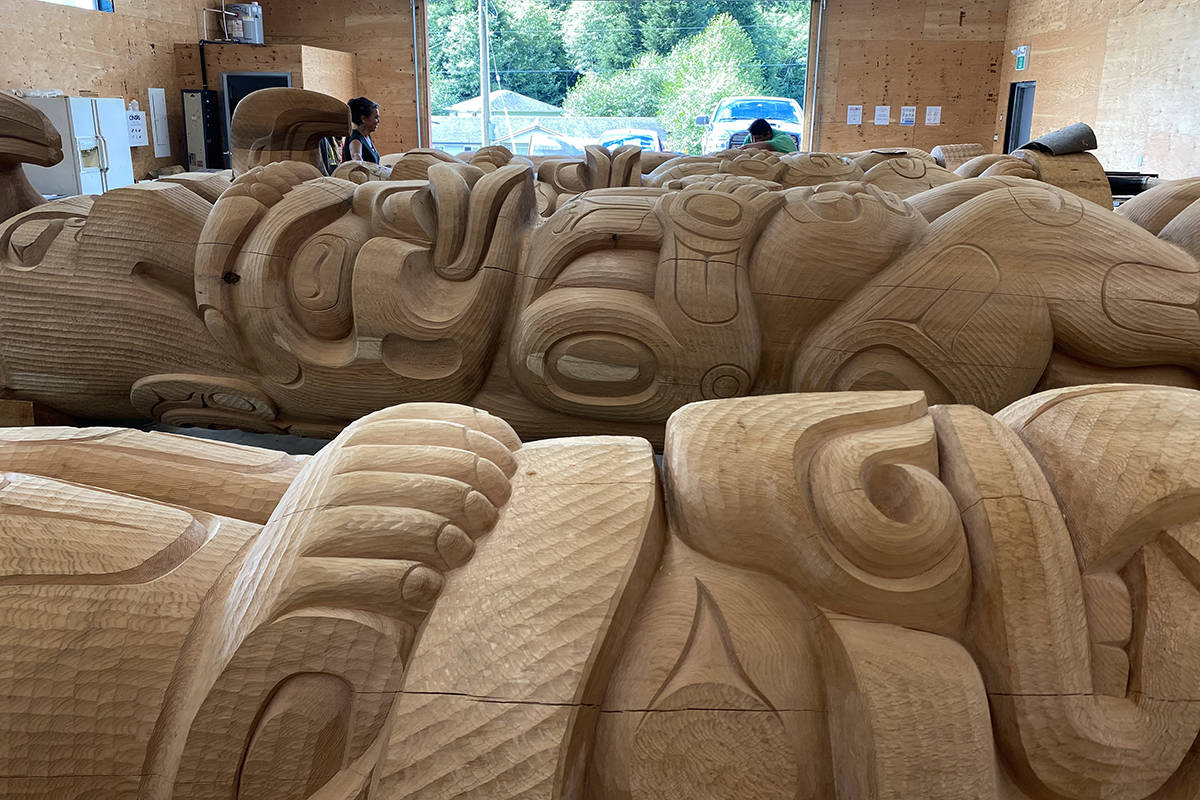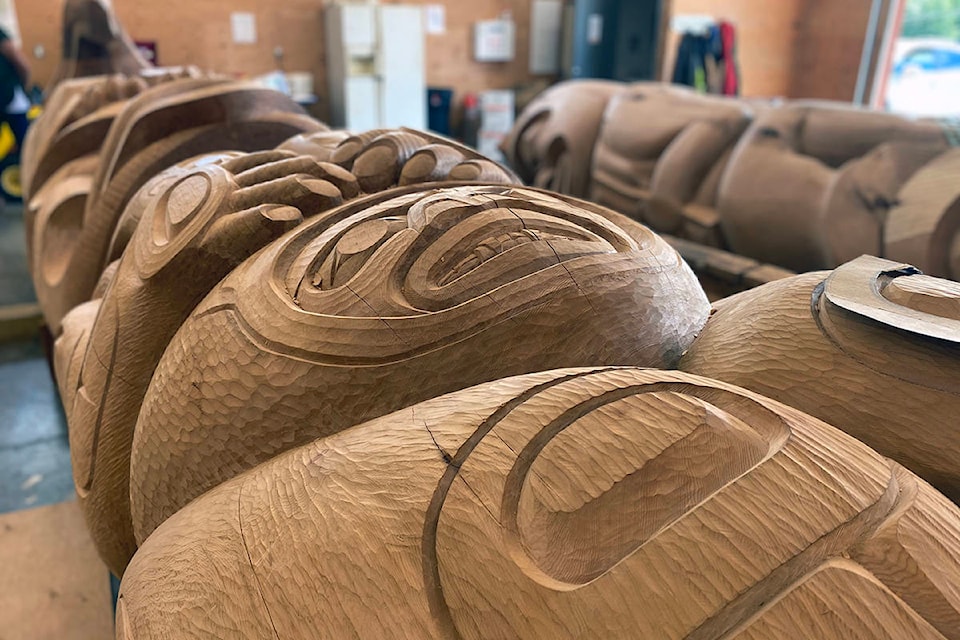Gwa’sala-‘Nakwakda’xw First Nations’ Big House, gukwdzi, is getting closer, one curl of cedar at a time. Master carver Junior Henderson has been working with a crew of young carvers to complete four house posts that will hold up the roof in the main room.
The four poles were harvested from Belize Inlet and Nahwitti Lake and have gradually taken on the shapes of dzunukwa, beavers, thunderbirds and a kolus. They equally represent the two nations, who were relocated from their homes at Smith Inlet, Takush, and Blunden Harbour, Ba’as, in the 1960s and have lived together at the Tsulquate reserve since. The crests were chosen by elders from both nations, and designed by head carver Bill Henderson, Junior’s uncle who taught him the art. Relatives Jonathan and Greg Henderson are also master carvers on the project. The mentee carvers are Walter Brown, Jeremy Wamiss, Alex Heuman and Talon George.
“It is a privilege and an honour to come up here and do this,” said Junior Henderson who is from Campbell River, and whose family has deep connections with the ‘Nakwaxda’xw Nation.
The job of a lead carver is more than just creating beautiful poles, it’s a way of life, he says.
Conversations in the carving shed are about cultural values and truths, as well as whittling techniques and joking around.
Henderson’s art carries on a legacy of a generation of artists who practiced their arts underground.
“Elders in those days were pretty tight. They knew how fragile this cultural way of life was,” he says, referring to the assimilation the Canadian government was trying to accomplish during his grandfather’s time.
“It doesn’t come to you, you have to go and find it. You have to sacrifice that time,” he said. Time he could have spent out fishing or pursuing other hobbies, he instead devoted to learning from his teachers. “I’m committed to this cultural way of life.”
Understanding his own family’s history, seeing a new Big House coming together is especially meaningful for Henderson.
| Walter Brown (L) and Junior Henderson (R) working on the fourth pole for Gwa'sala-'Nakwaxda'xw's Big House. (Zoë Ducklow) |
Since the Gwa’sala-‘Nakwaxda’xw Big House project formally began in 2018, design of the facility has gone through several rounds of consultation, especially with the remaining elders who remember what the original gukwdzi looked like and how they were used.
Joye Walkus, the project coordinator since Sept. 2019, estimates there are about a dozen people who still have that kind of first-hand knowledge.
The most recent change was the location. Gwa’sala-‘Nakwaxda’xw bought a plot of land on Park Drive, across the street from Tsulquate Park for the Big House.
But as discussions about the gukwdzi developed, it became clear that people really wanted it to be on the reserve, in the heart of their community.
It’s a governance building where leaders take care of community business, where rules and protocol are laid out, where ceremonies are held and feasts and potlaches are hosted.
“A Big House is ours. It’s ours to take care of from the ground up, to construct and put all of our gumption and our love into,” she said.
And so that land has been reallocated for housing (rezoning is currently underway), and two locations on reserve are being considered for the Big House.
Once a location is settled, Walkus will begin submitting applications for funding.
Previous applications were denied because details of the project weren’t ready yet, so this time they need to be “shovel ready.” Her goal is to have the application submitted this October, but is also determined to make sure the community is satisfied with the plans before pushing ahead.
Ideally, the opening feast will be a huge celebration, allowing members and friends to come celebrate.
But things might have to look differently now that the coronavirus is part of the world.
“We might host a couple of hundred people, spaced out, instead of a thousand,” Henderson said.
“The Big Houses were always sacred, ceremonial places to heal. A place not to be afraid. This is our healing, this is our help.”
Maybe a pandemic is actually the perfect time to be building a Big House.
| Reference photos for carving totem poles. (Zoë Ducklow) |
Do you have something to add to this story or something else we should report on? Email: zoe.ducklow@blackpress.ca
Like us on Facebook and follow us on Twitter.


